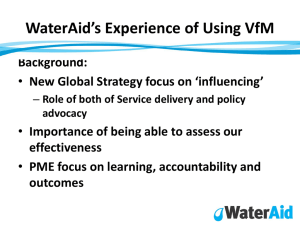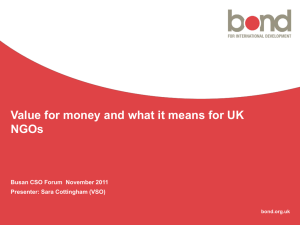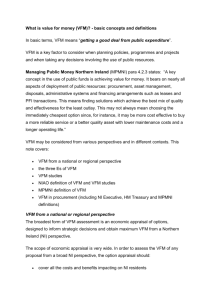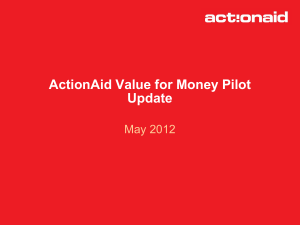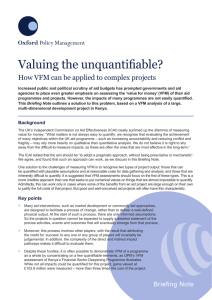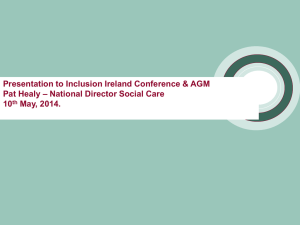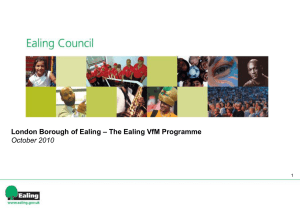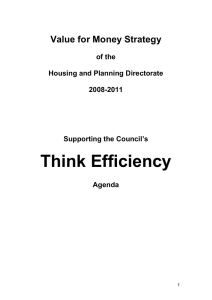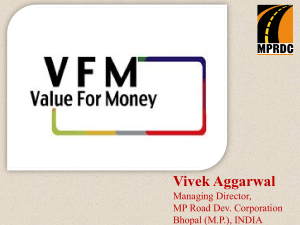The Value for Money of Behaviour Change
advertisement
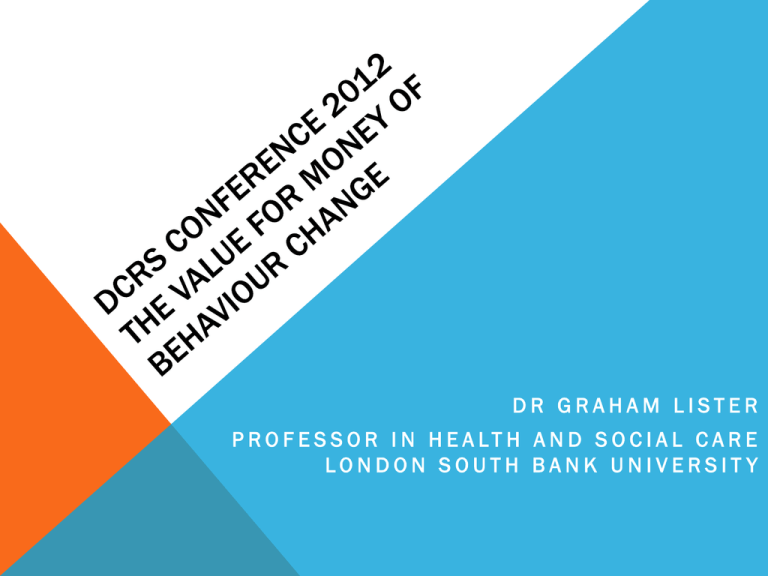
DR GRAHAM LISTER P R O F E S S O R I N H E A LT H A N D S O C I A L C A R E LONDON SOUTH BANK UNIVERSIT Y VALUE FOR MONEY TOOLS VfM tools are one element in a toolkit alongside: • Data Collection and Reporting Systems • Qualitative Reviews • Longitudinal Studies of Behaviour • Measures of Health and Social Impacts • National Research and Evaluation Programmes • Dialogue between Stakeholders CURRENT VFM TOOLS VfM tools include: • The Portsmouth Ready Reckoner for HT services • Cancer Research UK CAR Evaluation • / NICE tools for: • Smoking cessation • Alcohol harm reduction • Weight, diet and activity management • Breast feeding continuation • Response to bowel cancer surveys Free tools available at breakout session also at http://thensmc.com/resources/vfm Sign up for specialist training THE HT VFM TOOL USES Best available evidence on: • • • • • Costs and outcomes – from local programmes/ DCRS Impact on behaviour – from 2007 studies Consequences for health- from WHO National Burden of Disease Tool – applied to England 2004 Consequences for emotional well being Other social impacts – various studies as of 2010 You need to read the report to understand the evidence All tools can be improved as new evidence emerges PORTSMOUTH READY RECKONER 2:0 Update 2011 for: • Use of QALYs as well as DALYS • Update of WHO National Burden of Disease Tool • Update to reflect changes in behaviour • Sensitivity analysis (high and low estimates) • DH objection to weighting outcomes for disadvantage • CJS costs included in alcohol harm reduction Original study took 3 months cost £25,000 Tool 13 days cost £10,000 Update two days cost £1,500 WHAT THE TOOLS HELP YOU MEASURE Social value of impacts on: • Long term health outcomes taking into account persistence and health recovery cost per QALY • Future NHS and LA service cost savings • Family costs e.g. cost of consumption and care • Government costs e.g. Criminal Justice System OTHER ELEMENTS THAT CAN BE VALUED You can also negotiate values for: • Other HT services i.e. signposting, mapping, events • Offender Management Services • The value of addressing disadvantage • Using a Health England Formula or • Adding your own weight for disadvantage • But DH does not agree with this approach You Need Help HOW TO IMPROVE HEALTH TRAINER VfM Improve efficiency: • • • Reduce costs Increase throughput Improve behaviour change outcome s Increase focus on: • • • • • Disadvantaged groups (see weighting for disadvantage) And specifically offenders (potential for huge gains) Smoking → Emotional wellbeing → Diet and activity → Alcohol Younger clients (increases persistence and recovery rate) Support groups (increases persistence) POTENTIAL VfM IMPROVEMENTS Improve efficiency: typical results • • • Reduce costs , 20% ↑ = 46% VfM gain Increase throughput 20% ↑ = 40% VfM gain Improve outcomes 20% ↑ = 40% VfM gain Increase focus on: • • • • Disadvantaged 20% ↑ = 5% gain in weighted social return Offenders generate about £1,000 extra savings per client Specific areas of support make little difference Younger clients and support groups = VfM gain of 50-60% You can use the tool to explore this CAREFUL! Be open and honest: • Discuss assumptions between Commissioners and Providers • Try out options and improvements • Look at the range of results not just a single outcome • Don’t force super results, • A VfM of £5,000 per QALY is good • A VfM of up to £10,000 per QALY is acceptable • A VfM of – anything = a net saving and is very good indeed • Don’t use this tool in isolation remember the other tools • Describe the service and its outcomes then show the value You can always ask me g_c-lister@msn.com DR GRAHAM LISTER P R O F E S S O R I N H E A LT H A N D S O C I A L C A R E LONDON SOUTH BANK UNIVERSIT Y USING THE VfM TOOLS Always start with the clients and other stakeholders: • Talk to them understand their perspectives • Their objectives and how they will be measured • Understand the process of change and its costs and • Intended and unintended consequence of change A SOCIAL IMPACT MATRIX Objectives > Stakeholders ˅ Improved Health and Wellbeing Reduced inequality Improved social capital Reduce long term costs 1. Local Authorities Improved wellbeing QALY gain Disadvantaged and Hard to reach % IMD Membership of community groups Reduced social care and other service costs 2. NHS Improved health status QALY gain Reduce health inequality % IMD Better use of NHS services more participation Reduced NHS costs from associated conditions 3. Other Government As above As above Improved employment Tax, benefit, excise and VAT impacts 4. Clients Improved personal health status Access for disadvantaged and hard to reach More opportunities to participate and community support Employment income Less expenditure on addictive products and informal care 5. Community Better access to health and care Wider participation Increased volunteering Opportunities for cost sharing 6. Employers Reduced sickness and absenteeism Less long term sickness Improved staff relations Less costs of replacing staff better productivity CAUSAL CHAIN MAP Intended Improved patient booklet Nurse has less time with patient Greater empower ment Less empowerme nt if they don’t read English Unintended Better compliance Improved outcomes More patient choice Improved satisfaction Worse compliance Worse outcomes Less patient choice Worse satisfaction Increased inequality LETS LOOK AT THE TOOL Try out options to see impacts on VfM Input variables • Costs, • Types of client, • % achieving personal goals • Other – mapping, signposting, events • Disadvantaged %, weighting, reach If possible get out your Portsmouth ready reckoner and click along REMEMBER Tools produce a defensible answer to the question • How much is change worth in health and social terms? Based on best available evidence at the time • They need to be used, discussed and updated • Public Health England - should be doing this They give a broad estimate of probable long term outcomes • Best expressed as a range of possible values • You can’t predict exactly where and when savings will arise but probably when clients are 70-80 They are only part of your toolkit To become an evaluation expert Contact NSMC and get on a course Contact me at g_c-lister@msn.com
